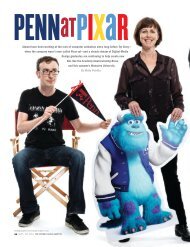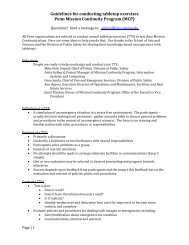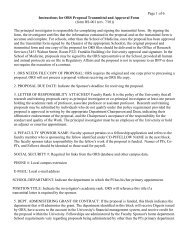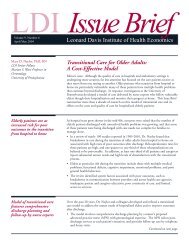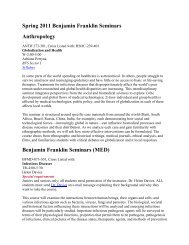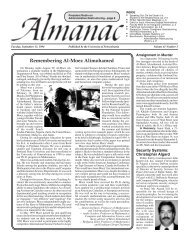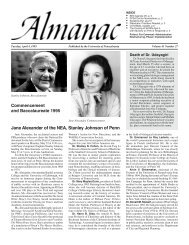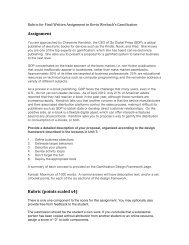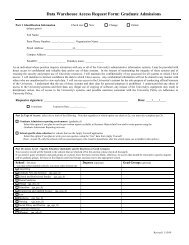2009-2010 COURSE REGISTER - University of Pennsylvania
2009-2010 COURSE REGISTER - University of Pennsylvania
2009-2010 COURSE REGISTER - University of Pennsylvania
Create successful ePaper yourself
Turn your PDF publications into a flip-book with our unique Google optimized e-Paper software.
Ricolais' structural models held by the<br />
Architectural Archives.<br />
This course will study the classification <strong>of</strong><br />
structural configurations in orderto consider<br />
the significance <strong>of</strong> their dimensionality,<br />
directionality, axes <strong>of</strong> restraint and degrees<br />
<strong>of</strong> freedom. The taxonomy <strong>of</strong> braced<br />
frameworks in general and trussed beams in<br />
particular will be considered. There will be<br />
structural analysis <strong>of</strong> trusses using graphic<br />
statics and computer techniques. Students<br />
will either interpret a truss patented in the<br />
United States or experiment on the<br />
structure and geometric space <strong>of</strong> the<br />
braided tensile truss. Interpretations will<br />
include an explanation <strong>of</strong> the historical<br />
facts, built examples and a<br />
computerstructural analysis; an evaluation<br />
<strong>of</strong> its efficiency in terms <strong>of</strong> strain energy<br />
for a given potential energy, and in<br />
comparison to A.G. Mitchell's minimum<br />
volume frameworks; an expression <strong>of</strong> the<br />
rational improvements that could be<br />
proposed.<br />
732. Building Systems Integration.<br />
(A) Malkawi.<br />
This course explores the interrelationships<br />
<strong>of</strong> environmental control systems by means<br />
<strong>of</strong> building type studies. Innovative<br />
systems will be emphasized. Projects such<br />
as residential, educational and commercial<br />
buildings, <strong>of</strong>fice and assembly buildings.<br />
The relationship between energy<br />
conservation and the principles <strong>of</strong> initial<br />
building cost versus life cycle costs will be<br />
discussed.<br />
739. (HSPV551) Building Pathology.<br />
(M) Henry.<br />
This course addresses the subject <strong>of</strong><br />
building deterioration and intervention,<br />
with the emphasis on the technical aspects<br />
<strong>of</strong> deterioration. Construction and<br />
reconstruction details and assemblies are<br />
analyzed relative to functional and<br />
performance characteristics. Case studies<br />
cover subsurface conditions, structural<br />
systems, wall and ro<strong>of</strong> systems, and interior<br />
finishes with attention to performance,<br />
deterioration, and stabilization or<br />
intervention techniques.<br />
741. Contemporary Processes in<br />
Architecture: Experimental Design &<br />
Its Effects. (A) Rahim. The mastery <strong>of</strong><br />
techniques, whether in design, production<br />
or both, does not necearchitecture. As we<br />
all know, the most advanced techniques can<br />
still yield average designs. Architects are<br />
becoming increasingly adept at producing<br />
complexity and integrating digital design<br />
and fabrication techniques into their design<br />
process - yet there are few truly elegant<br />
projects. Only certain projects that are<br />
sophisticated at the level <strong>of</strong> technique<br />
achieve.<br />
The mastery <strong>of</strong> techniques, whether in<br />
design, production or both, does not<br />
necearchitecture. As we all know, the most<br />
advanced techniques can still yield average<br />
designs. Architects are becoming<br />
increasingly adept at producing complexity<br />
and integrating digital design and<br />
fabrication techniques into their design<br />
process - yet there are few truly elegant<br />
projects. Only certain projects that are<br />
sophisticated at the level <strong>of</strong> technique<br />
achieve elegance. This seminar explores<br />
some <strong>of</strong> the instances in which designers<br />
are able to move beyond technique, by<br />
commanding them to such a degree so as to<br />
achieve elegant aesthetics within the formal<br />
development <strong>of</strong> projects.<br />
744. (IPD 544) Digital Fabrication. (B)<br />
Faculty.<br />
A seminar and design workshop that<br />
explores associative and parametric CAD-<br />
CAM strategies, to enable an interactive<br />
continuity between conception and<br />
fabrication. Through parametric 3D<br />
constructions, students will explore how to<br />
link dink different aspects <strong>of</strong> the<br />
architectural projects, such as: (1) design<br />
intention; (2) control <strong>of</strong> variation and<br />
adaptation; (3) construction constraints; (4)<br />
digital fabrication processes. The course<br />
emphasizes the cross-fertilization <strong>of</strong><br />
formal, technical and performative aspects<br />
<strong>of</strong> the design activity.<br />
SM 745. Information Culture. (A)<br />
DiSimone.<br />
Systems biology examines the nature <strong>of</strong><br />
nonlinearities, emergent properties and and<br />
loosely coupled modules that are the<br />
hallmarks <strong>of</strong> 'complexity'. New models and<br />
design in architecture have grown in<br />
response to radical breakthroughs in in<br />
technology and an increasing interest in the<br />
use <strong>of</strong> algorithmic and generative tools<br />
within the design process. Algorithmic<br />
imagingand molecular tools found useful in<br />
analyzing nonlinear biological systems may<br />
therefore prove to be <strong>of</strong> value to new<br />
directions in design within architecture.<br />
This course explores the potential <strong>of</strong><br />
dialogues between architecture and<br />
nonlinear systems biology to gain insight<br />
into living systems,develop techniques for<br />
digital modeling, and create experimental<br />
designs with rigor at various length scales,<br />
from the microscopic to the human. Part<br />
seminar and part workshop, it serves to<br />
deepen knowledge <strong>of</strong> nonlinear<br />
biosynthesis,a synthesis <strong>of</strong> design thinking<br />
and tooling through the study <strong>of</strong> systems<br />
biology. Students will develop a series <strong>of</strong><br />
ARCHITECTURE<br />
digital and physical models through the<br />
through the use <strong>of</strong> a 3D printer and a<br />
diverse range <strong>of</strong> scripting and modeling<br />
techniques in parametric and associative<br />
s<strong>of</strong>tware. The final assignment is a<br />
748. Advanced Digital Media. (B)<br />
Faculty.<br />
Technique: a method <strong>of</strong> accomplishing a<br />
desired effect. Media: the material/virtual<br />
means <strong>of</strong> transmission <strong>of</strong> the desired effect.<br />
This seminar will investigate specific<br />
media-based techniques and their latent<br />
ideologies through the analysis <strong>of</strong> selected<br />
paintings, photographs and films. Lectures<br />
and discussions <strong>of</strong> selected texts will<br />
examine how these techniques have<br />
impacted architectural culture in the<br />
modern period. A critical study <strong>of</strong> learned<br />
perceptions and conventions <strong>of</strong> seeing and<br />
<strong>of</strong> the media that stand between that which<br />
we believe to be real and the image will<br />
serve as the basis for creative investigations<br />
into depictions <strong>of</strong> space and material using<br />
digital media. By introducing themes that<br />
outline intersections between mediaspecific<br />
techniques and architectural<br />
practice, the course will enable the creative<br />
exploration <strong>of</strong> new methodologies and<br />
techniques related to digital media and its<br />
implications on the representation and<br />
formation <strong>of</strong> space. There will be a<br />
required presentation that will be developed<br />
into a final paper or project.<br />
752. (CPLN760, UDES752) Case<br />
Studies in Urban Design. (B) Hack.<br />
Through three case studies and a final<br />
project this course explores several<br />
fundamentally different ways in which the<br />
urban design process is realized in this<br />
country: The campus as historical prototype<br />
and contemporary paradigm; the new<br />
community both modernist and neotraditionalist;<br />
expansion/relocation <strong>of</strong> CBD;<br />
and urban/suburban in-fill. Particular<br />
emphasis is placed on the roles <strong>of</strong> planning,<br />
historic preservation and landscape<br />
architecture in the practice <strong>of</strong> urban design.<br />
762. (ARCH462) Design and<br />
Development. (B) Rybczynski.<br />
This course provides an introduction to the<br />
relationship between architectural design<br />
and real estate development. Following a<br />
discussion <strong>of</strong> fundamentals, examples focus<br />
on commercial building types, and illustrate<br />
how architectural design can contribute to<br />
real estate development. Topics include<br />
housing designcommercial buildings,<br />
adaptive reuse, downtown development,<br />
mixed-use projects,and planned<br />
communities. The course consists <strong>of</strong><br />
lectures, reading assignments, short essays,<br />
a group project, and an mid-term test.<br />
Page 41



